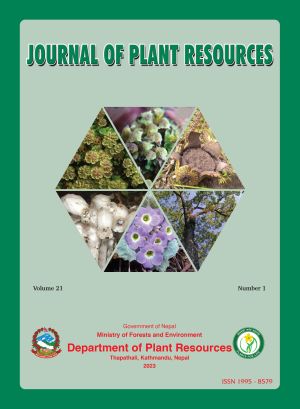Phytochemical Studies and Toxicity Evaluation of Selected Medicinal Plants from Sarlahi District, Nepal
DOI:
https://doi.org/10.3126/bdpr.v21i1.57199Keywords:
Antioxidant activity, Azadirachta indica, Brine shrimp, Folin-Ciocalteu reagentAbstract
Medicinal plants play a vital role in primary health care and the development of herbal drugs at low prices and with fewer side effects. The aim of the present work is focused on the study of antioxidant activity, cytotoxicity, phytochemical screening, and estimation of total phenolic and flavonoid contents of Achyranthes aspera, Azadirachta indica, Cascabela thevetia, Catharanthus roseus, Clerodendrum indicum, C. infortunatum, Oxalis latifolia, Paederia foetida and Tinospora cordifolia from Sarlahi district, Nepal. Total phenolics and flavonoids were estimated by Folin-Ciocalteu and aluminum chloride methods respectively. The antioxidant activity and toxicity were evaluated by 2, 2-diphenyl-1-picrylhydrazyl (DPPH) method and brine shrimp lethality method respectively. Among the plants studied, A. indica contained the highest phenolic content (250.08 ± 0.319 mg GAE.g-1 of dry extract) and O. latifolia showed the highest flavonoid content (112.47 ± 0.07 mg QE.g-1 dry extract). Methanolic extract of the bark of A. indica, the root of Clerodendrum infortunatum, and the stem of C. indicum showed potent in vitro antioxidant activity with IC50 values of 14.84 ± 2.250 µg.mL-1, 23.94 ± 2.245 µg.mL-1, and 29.93 ± 0.993 µg.mL-1 respectively as compared to the standard ascorbic acid with an IC50 value of 9.44 ± 0.902 µg.mL-1. All nine selected medicinal plants showed low toxicity towards the larvae of Artemia salina in dose dependent pattern. The results of this study approve the traditional use of the medicinal plants by the local people.




